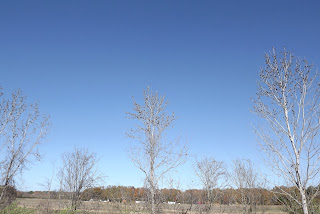During the fall and winter, many species of blackbirds travel in flocks, foraging in a variety of places for seeds and insects. While some of these flocks are composed of only one species—for example, Red-winged Blackbirds—others may be mixed-species flocks. How do you tell which species comprise a particular mixed-species group that you're observing in the field?
Although it can be overwhelming at first, looking closely at individual birds in large groups of blackbirds will give you the practice you need to identify those species much more quickly. Here is a flock of blackbirds swarming the upper branches of three tall trees:
When you examine the flock more closely, you can see that it is made up of Brown-headed Cowbirds and Red-winged Blackbirds. There is an obvious flash of red on the wing of a male Red-winged Blackbird, and the female Red-wings have pale "eyebrows" and are densely streaked with brown. The Brown-headed Cowbirds—clay-colored females and brown-headed males—are also fairly easy to pick out.
Can you spot the Brown-headed Cowbirds on the wires in the following photo? A second species is present, as well.
Here is a close-up of the two species: Brown-headed Cowbird and European Starling (the bird on the right). Starlings are not in the same family as North American blackbirds, although they frequently flock with them. Studies indicate that mixed-species flocking helps birds to evade predators.
 |
| Starlings have longer bills than cowbirds, and their plumage in the winter is speckled with white. |
Some blackbirds, like Common Grackles, are easy to identify because of their larger size and proportionally long tails. These features contrast strongly with those of other, smaller species. However, even in single-species flocks, grackles' lankiness is distinctive.
 |
| Common Grackles seem too big for tube feeders! |
The Brewer's Blackbird is another fairly common species in eastern North America, and its shape and proportions make it appear more like a "standard" songbird. The males, like the one below, have glossy, dark, iridescent plumage and pale eyes, while the females have dark eyes and are browner. The Brewer's Blackbird tends forage in open areas, such as agricultural fields.
 |
| Brewer's Blackbirds shine in the sun. |
The Rusty Blackbird is a widespread species that, sadly, has experienced steep population declines—likely as a result of climate change and habitat loss—over the last several decades. Although it has become scarce, you can still occasionally find larger flocks of these birds during the colder months. As the name suggests, both males and females have rust-brown coloration in the winter (although males are black in the breeding season).
 |
| Bottomland hardwood forests—or habitats at the borders of these types of woods—are particularly attractive to Rusty Blackbirds during the winter. |
 |
| Notice the rusty barring and pale eyes. |
While several other blackbirds and associated species occur in North America, these are the most common ones over much of the eastern region. The next time that you're in the field, take a closer look at blackbird flocks—you may be surprised at the diversity of species that you find!




No comments:
Post a Comment